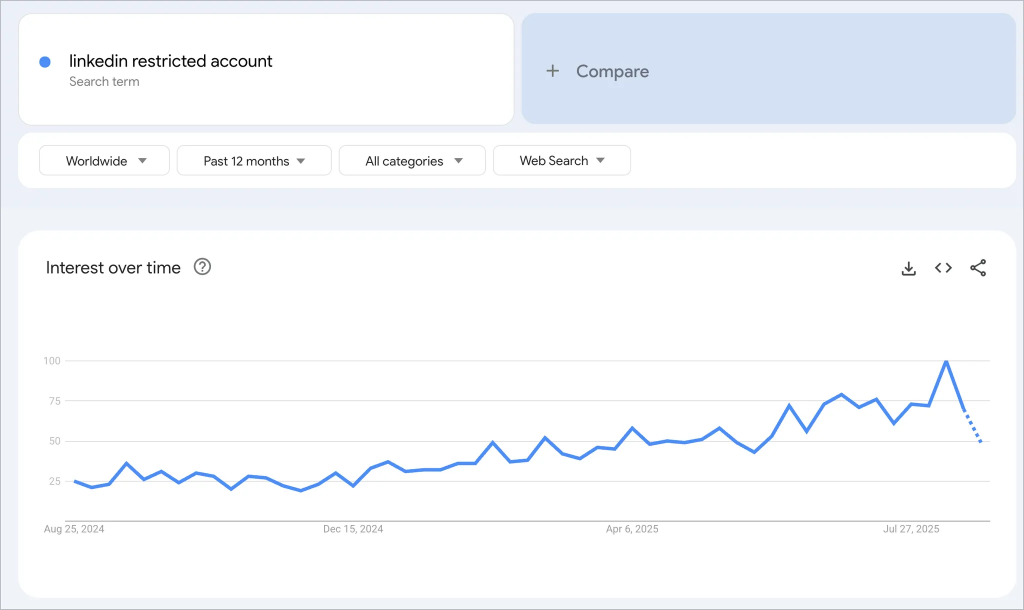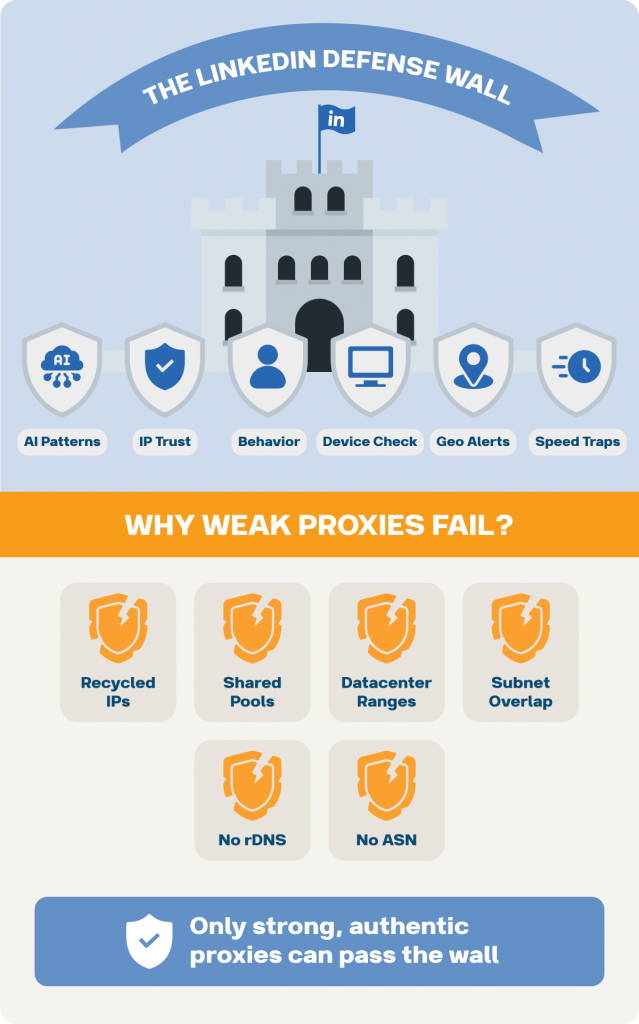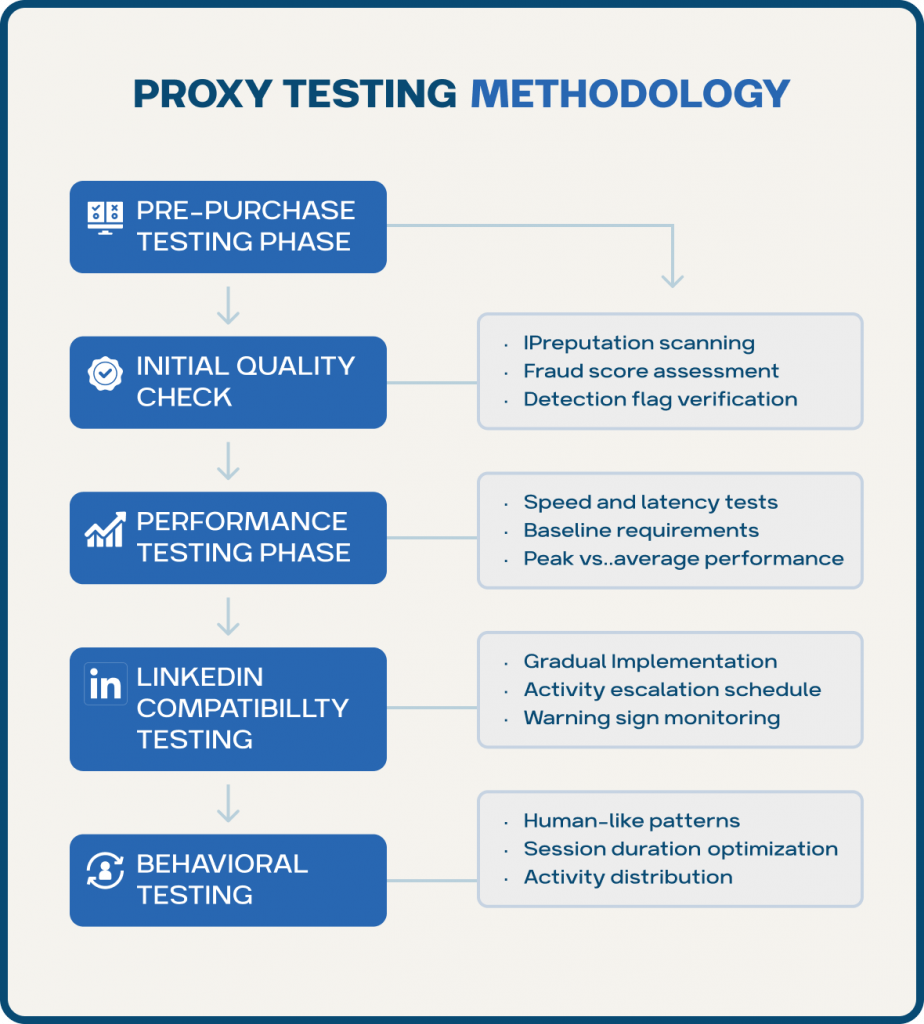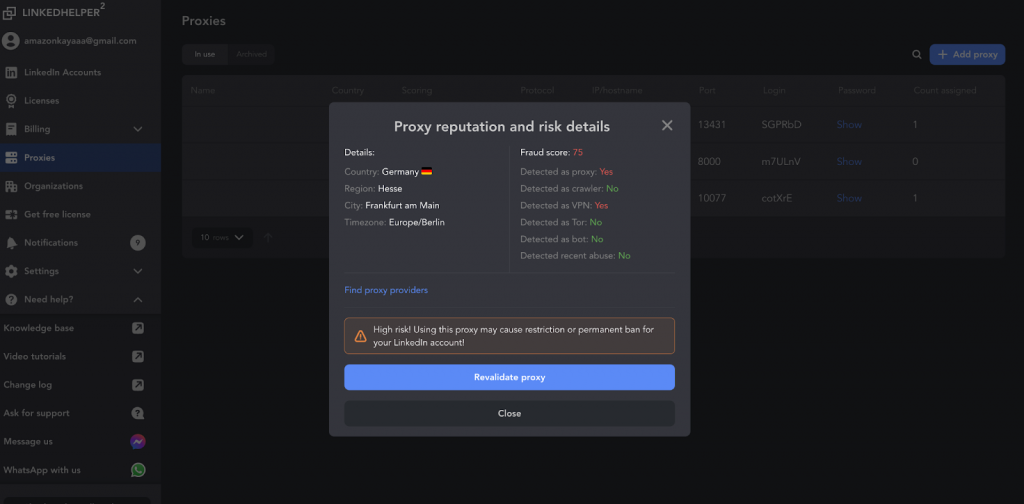
A proxy is an intermediary server that sits between your browser/automation tool and LinkedIn.
In the context of automation, proxies control how LinkedIn sees your sessions: geography, IP reputation, session persistence, and traffic patterns.
95% of LinkedIn automation users get hit with restrictions in the first 30 days.
Pick the wrong proxy and you don’t get safety — you get a faster restriction!
The market is noisy: dozens of vendors claim “LinkedIn-safe” proxies, but marketing rarely equals independent proof.

With so many offers, it’s impossible to know which providers actually protect your LinkedIn accounts.
When proxies are needed in LinkedIn automation:
- Running multiple LinkedIn accounts from one device/IP
- Managing accounts for clients or team members in different regions
- Ensuring local IP addresses to match target markets (US, EU, APAC, etc.)
- Scraping data or running high-volume campaigns at scale
- Reducing risk of suspicious login flags and restrictions
What you’ll get here: proxy types, 27 testing parameters, how we ran the experiment, and the exact setup that actually works.
See the $2,000 Proxy Testing Experiment published in our community.
TL;DR
- Test proxies (27 checks): speed, latency, fraud score, blacklist, location match, stability.
- Top locations: 🇨🇦 Canada, 🇩🇪 Germany, 🇳🇱 Netherlands, 🇬🇧 UK, 🇺🇸 USA.
- Avoid: 🇮🇳 India, 🇧🇷 Brazil, 🇷🇺 Russia, 🇨🇳 China, 🇻🇳 Vietnam.
- Best practices: one proxy = one account, align geo + timezone, monitor warnings, invest in quality → cheap = bans.
Understanding How LinkedIn Detects Automation in 2025

LinkedIn automation in 2025 is harder than ever. The platform uses advanced proxy detection and strict IP reputation scoring, so running the wrong setup usually gets accounts restricted fast.
How LinkedIn spots automation:
- Machine learning → identifies repeated automation patterns across accounts
- IP reputation → every login is scored against global blacklists
- Behavioral analysis → unusual typing, clicking, and session time = risk
- Device fingerprinting → cross-checks fingerprints + IP history for automation
- Geo impossibility → logins from different countries in one day trigger alerts
- Connection velocity → too many invites/messages in a short period of time = instant review
Why most proxies fail:
- Recycled IPs → already flagged in IP reputation systems
- Shared pools → heavy bot use = fast proxy detection
- Datacenter IPs → entire ranges pre-blacklisted
- No residential ASN → doesn’t pass for a real user on LinkedIn automation
- Missing reverse DNS → easy to catch fake proxies
- Subnet concentration → many accounts on same block = detection patternBottom line: in 2025, LinkedIn automation lives or dies by clean proxie
- s, strong IP reputation, and avoiding LinkedIn’s advanced proxy detection systems.
Types of Proxies: What Works and What Doesn’t
Success Rate = % of proxies marked “Good” by IPQualityScore (not flagged as VPN/proxy/abuse).
| Parameter | Datacenter Proxies | Residential Proxies | ISP Proxies | Mobile Proxies |
| Success Rate | ~10% | ~75% | ~85% | ~90% |
| Protocol Type | IPv4 / IPv6 | IPv4 | IPv4 | IPv4 |
| Detection Risk | Very high (easily flagged) | Low (residential legitimacy) | Moderate (depends on quality) | Lowest (most natural) |
| Speed / Latency | Very fast | Moderate | High-speed (near datacenter) | Slower than datacenter/ISP |
| Session Stability | Excellent stability | Good (safer if sticky sessions are available) | Excellent (long sessions) | Moderate stability (depends on network) |
| Geographic Authenticity | Weak (IPs clustered in server farms) | Strong (diverse locations) | Strong (real ISP regions) | Very strong (matches mobile carriers) |
| Cost | Cheapest | Higher cost | Moderate to expensive | Most expensive (per GB pricing) |
| Scalability | High (cheap & many IPs) | Moderate (expensive + limited location coverage) | Moderate (limited location coverage) | Limited by high cost |
| Best Use Case | Web scraping, SEO tasks | LinkedIn outreach, ad verification | Long-term LinkedIn accounts, sales teams | VIP accounts, ultra-safe automation |
| Biggest Weakness | IPs easily detected as proxy | High price, smaller pools | Inconsistent quality | Very expensive, slower speed |
Choosing the right proxy type is critical for LinkedIn. Here’s how datacenter proxies, residential proxies, ISP proxies, and mobile proxies compare in real use.
Datacenter Proxies (10% Success Rate)
Datacenter proxies are cheap and fast, but they almost never work for LinkedIn automation. Here’s why:
- Easily identifiable IP ranges → LinkedIn knows datacenter blocks. These IPs stick out compared to normal user traffic.
- No residential ISP association → They don’t belong to a real internet provider, so LinkedIn treats them as suspicious.
- Mass blacklisting by platforms → Whole datacenter ranges are banned across multiple platforms, LinkedIn included.
- When they might work → Fine for scraping or testing low-value data. But for LinkedIn, datacenter proxies are instant risk.
👉 Bottom line: datacenter proxies = fast way to a restricted account.
Residential Proxies (75% Success Rate)
Residential proxies come from real user devices, which makes them look natural to LinkedIn’s systems.
These IPs are tied to real internet providers, giving them a strong IP reputation and higher trust.
- Rotation vs. sticky sessions → You can switch IPs every request (rotation) or keep the same one for hours (sticky). Sticky feels more human for LinkedIn.
- Mobile vs. home connections → Mobile residential proxies mimic smartphones, while home IPs look like desktop users. Both work, depending on your campaign.
- Geographic authenticity → The proxy IP must match the country listed in your LinkedIn account settings.
Common quality issues to watch for → Some providers recycle abused IPs, concentrate too many users on one subnet, or lack clean pools. These problems can tank your success rate.
👉 Best option if you need scale and flexibility: residential proxies.
ISP Proxies (85% Success Rate)
Why ISP proxies are optimal:
- Static IPs
- Datacenter speed with residential legitimacy
- Long session capability
- Selection criteria
ISP proxies are often considered the sweet spot for LinkedIn automation. They mix the stability of residential proxies with the speed of datacenter proxies, making them one of the most reliable choices.
- Static IPs → ISP addresses stay stable, which helps build a consistent IP reputation.
- Datacenter speed with residential legitimacy → You get the performance of datacenter proxies, but the trust level of residential proxies.
- Long session capability → Perfect for LinkedIn sessions that need to stay logged in for hours without raising flags.
- Higher cost but better reliability → More expensive than standard residential proxies, but worth it for reduced bans and smoother campaigns.
- Selection criteria → Look for providers with diverse subnets, fresh pools, and transparent replacement policies.
👉 For most teams, ISP proxies give the best balance between safety, speed, and cost.
Mobile Proxies (90% Success Rate)
Mobile proxies are the premium choice for LinkedIn automation. They’re the closest you can get to looking like a real human user online.
- 4G/5G connections → Traffic comes from actual mobile carriers, so LinkedIn treats it as authentic smartphone activity.
- Natural IP rotation → Mobile networks rotate IPs constantly, which makes detection nearly impossible.
- Highest trust scores → Because they mimic real devices, mobile proxies carry the best IP reputation of any type.
- Cost considerations → They’re the most expensive option, often priced per GB instead of per IP. Scaling with them can get costly.
- Use case scenarios → Best for VIP accounts, high-value outreach, or situations where account safety is more important than budget.
👉 If safety is your #1 priority, mobile proxies are unmatched.
Learn The 27 Critical Parameters for Testing Proxy Quality in our community.
Category 1: Quality & Detection Metrics (8 Parameters)
- Fraud Score (0-100 scale)
What it Measures: A fraud score indicates the risk level of an IP address being flagged as suspicious. It’s calculated using global databases of abusive behavior, bot activity, and proxy usage.
Acceptable Ranges:
- <30 = Excellent (safe for LinkedIn automation)
- 30–65 = Good (some risk, acceptable for testing)
- >65 = Risky (avoid for LinkedIn)
How to Test: Use services like IPQualityScore, Scamalytics, or FraudScore API during proxy testing.
Impact on Automation: A high fraud score leads to failed logins, temporary bans, or hard account locks on LinkedIn.
- Proxy Detection Flag
What it Measures: Whether the proxy is already flagged as a known proxy by detection systems. This is often a binary Yes/No.
How to Test: Proxy testing with tools like IP2Proxy or Whoer.net.
Impact on Automation: If the proxy is flagged, even high-speed and low-latency connections won’t save it — LinkedIn will instantly distrust the session.
3. VPN Detection
While proxy detection checks if traffic is routed through known proxy services, VPN detection looks for IPs tied to large commercial VPN providers. These IP blocks are easy to fingerprint because they’re shared by thousands of users at once.
Why it Matters: VPNs are overexposed and carry poor IP reputation. LinkedIn automation almost always fails with VPNs because they show up in risk databases immediately.
4. Bot Activity History
If an IP was previously used for spam bots, scraping, or brute-force attempts, its reputation stays damaged even if it’s technically “clean” now.
Checking Methods: Use abuse-reporting databases like AbuseIPDB or security APIs (IPQS, Scamalytics) during proxy testing to uncover historical patterns.
5. Crawler / Scraper Association
Database Contamination: Many datacenter proxies are tagged as part of known scrapers (SEO tools, data harvesters). Once in these lists, the IP inherits a permanent risk flag.
Recovery Possibility: Almost none. Once an IP is tied to mass crawling activity, reputation rarely recovers, making it useless for LinkedIn automation.
6. Recent Abuse Detection
LinkedIn and similar platforms monitor activity in 24h–72h rolling windows. If an IP was abusive during this time, it’s marked high-risk.
Cleaning Periods: Some IPs “cool off” after weeks of no abuse, but most remain tainted in fraud score databases for months.
7. Spam Score
Spam scoring systems track whether an IP has been linked to email blasts, spam bots, or bulk messaging tools.
Cross-Platform Implications: A proxy with a high spam score might still connect to LinkedIn, but accounts using it will be flagged for aggressive messaging limits or shadow bans.
8. Blacklist Status
Major Blacklist Databases: Spamhaus, Barracuda, Talos Intelligence, Google Safe Browsing, and SORBS are the most influential lists.
Proxy testing should include weekly checks across multiple blacklists, since IPs can get listed after just one abusive incident.
Category 2: Technical Performance (8 Parameters)
Performance Metrics:
Download / Upload Speeds
- Proxies must hit minimum thresholds (10 Mbps down, 5 Mbps up) to ensure smooth campaigns.
- Low speeds instantly downgrade overall proxy quality.
Latency
- Optimal: <100ms, Acceptable: <300ms.
- High latency creates suspicious delays and lowers proxy quality during LinkedIn automation.
Connection Stability & Packet Loss
- Even small packet loss or frequent disconnects force automation tools to re-send or duplicate requests.
- This increases activity patterns LinkedIn’s systems flag as risky.
- Stable, clean connections = lower noise + safer automation.
Protocol Support (HTTP/HTTPS/SOCKS5)
- HTTP/HTTPS is enough for most LinkedIn tasks.
- SOCKS5 offers stronger encryption and better proxy quality for long-term automation.
IPv4 vs IPv6 Considerations
- LinkedIn works fine with both IPv4 and IPv6 protocols.
- Datacenter IPv6 is usually much cheaper than IPv4, but LinkedIn easily detects it as proxy traffic → higher restriction risk.
- If an ISP or residential provider offers IPv6, it can be safe — as long as the address has a clean history (not flagged for spam).
- IPv4 remains the most reliable option for LinkedIn automation, but it’s more expensive due to limited availability.
Concurrent Connection Limits
- In theory, concurrency = how many simultaneous connections a proxy can handle.
- For LinkedIn automation, this is mostly irrelevant because the safest setup is one proxy per account.
- Running multiple accounts on the same proxy may cause LinkedIn to link them together → higher restriction risk.
Session Duration Capabilities
- Sticky sessions (30+ mins) maintain trust and prevent suspicious rotations.
- Short sessions lower proxy quality by forcing frequent IP changes.
Category 3: Geographic & Network Diversity (6 Parameters)
- Country-Level Success Rates
- The safest option is when the proxy IP country matches the country listed in the LinkedIn account.
- A clean ISP or residential IP from any country (even India, Vietnam, etc.) is safe if it aligns with the account’s country settings.
- Problems usually come from cheap providers in certain regions, where IPs are already flagged for abuse.
- The safest option is when the proxy IP country matches the country listed in the LinkedIn account.
- State/City Targeting Accuracy
- High-quality residential proxies and ISP proxies allow precise targeting.
- Wrong geolocation data = LinkedIn logins trigger security checks.
- Essential for recruiters or sales teams working regionally.
- High-quality residential proxies and ISP proxies allow precise targeting.
- ASN Diversity Importance
- ASN (Autonomous System Number) identifies the network/ISP.
- Using the same ASN repeatedly lowers proxy quality and makes automation easier to detect.
- Diverse ASNs = more natural traffic patterns.
- ASN (Autonomous System Number) identifies the network/ISP.
- Subnet Distribution (/24 Blocks)
- If too many proxies come from the same /24 subnet, LinkedIn detects clustering.
- Balanced subnet distribution is a key proxy quality factor for agencies managing multiple accounts.
- If too many proxies come from the same /24 subnet, LinkedIn detects clustering.
- Reverse DNS Configuration
- Proper rDNS makes the IP look like a real residential or ISP connection.
- Missing or datacenter-style rDNS lowers trust and hurts proxy quality.
- Proper rDNS makes the IP look like a real residential or ISP connection.
- Geographic Impossibility Risks
- Example: Account usually logs in from Paris → suddenly from Tokyo within 2 hours.
- LinkedIn flags this as impossible travel, reducing session trust.
- Solution: Keep geographic consistency with sticky residential proxies.
- Example: Account usually logs in from Paris → suddenly from Tokyo within 2 hours.
Category 4: Operational Factors (5 Parameters)
Replacement Policies and Speed
- Top providers replace bad proxies fast (within hours).
- Slow or no replacement = wasted spend and weaker proxy quality over time.
Uptime Guarantees
- Look for SLAs of 99%+ uptime.
- Frequent downtime disrupts LinkedIn automation campaigns and lowers efficiency.
Support Response Times
- Fast, 24/7 support = critical when proxies fail mid-campaign.
- Long delays increase risk of LinkedIn account restrictions.
Minimum Purchase Requirements
- Some vendors force bulk buys (e.g., 100 proxies minimum).
- Flexible plans are better for testing proxy quality before scaling.
Trial Availability
- Risk-free trials let you run real proxy testing before committing.
- Without trials, you gamble on unknown proxy quality.
Country-Specific Proxy Performance Analysis
| Country | Success Rate | Trust Level | Key Notes |
| Canada | 85% | ✅ High | Strong privacy laws, clean IPs |
| Germany | 82% | ✅ High | GDPR, reliable ISPs |
| Netherlands | 80% | ✅ High | Tech-forward, stable |
| UK | 78% | ✅ Medium-High | Consistent residential networks |
| USA | 75% | ⚠️ Mixed | Large pool, requires testing |
| Brazil | 40% | ❌ Low | Fraud associations |
| India | 35% | ❌ Low | Oversaturated, recycled IPs |
| Vietnam | 38% | ❌ Low | Bot farm links |
| Russia | 30% | ❌ Very Low | Political/cybersecurity flags |
| China | 25% | ❌ Very Low | Firewall issues, unstable |
Top Performing Countries and Why
Canada (85% success rate)
Strong privacy laws and top-tier internet infrastructure make Canadian proxy locations highly trusted for LinkedIn automation. Clean residential networks = fewer bans.
Germany (82% success rate)
GDPR protections and reliable ISPs give Germany one of the highest trust scores. Perfect for geographic targeting in EU-focused campaigns.
Netherlands (80% success rate)
Known for tech-forward infrastructure and stable connections. Dutch proxies combine speed with legitimacy.
UK (78% success rate)
Established residential networks and consistent IP reputation make the UK a reliable choice for proxy locations.
USA (75% success rate)
Huge proxy pool with lots of residential options. Quality is mixed — some ISPs have excellent reputation, others get flagged fast. Careful proxy testing is key here.
Countries to Avoid
India (35% success rate)
Oversaturated, many proxies recycled across users. Poor reputation in automation databases.
Brazil (40% success rate)
High fraud associations make Brazilian IPs risky for LinkedIn.
Russia (30% success rate)
Automatic suspicion due to political and cybersecurity concerns. Accounts often locked immediately.
China (25% success rate)
The Great Firewall complicates connections and makes geographic targeting unreliable.
Vietnam (38% success rate)
Known for bot farms and scraper associations, lowering proxy trust drastically.
Step-by-Step Proxy Testing Methodology + LH feature

Ensuring your proxies are reliable before linking them to accounts is critical. A solid proxy testing framework helps you identify weak IPs, avoid unnecessary bans, and maintain long-term account stability.
With the new Linked Helper proxy validation feature, you can also run an integrated IP quality check to see if an address has a clean history or a high fraud score. The feature is free for Linked Helper users.

Pre-Purchase Testing Phase
- Request Trial Access – Always ask providers for trial IPs before committing. A minimum of 5 IPs per location is recommended.
- Subnet Diversity – Test IPs from different subnets to avoid cluster bans.
- 24-Hour Test Period – Run checks over a full day to capture both peak and off-peak conditions.
Initial Quality Check
- IP Reputation Scanning – Use services like IPQS to measure trustworthiness.
- Fraud Score Assessment – Review the fraud score; higher values signal risky proxies.
- Detection Flag Verification – Confirm whether the IP is marked as VPN, proxy, or crawler.
💡 With Linked Helper’s built-in proxy testing tool, this process is automated. The platform performs an IP quality check, showing you if your proxy is Good (safe to use) or Bad (replace recommended).
Performance Testing Phase
- Speed and Latency Tests
- Run download/upload benchmarks.
- Acceptable latency: <300ms (ideal: <100ms).
- Compare peak vs. average results.
- Run download/upload benchmarks.
- Stability Testing
- Keep the proxy connected for 24 hours.
- Track dropout frequency and recovery times.
- Keep the proxy connected for 24 hours.
LinkedIn Compatibility Testing
- Gradual Implementation – Begin with just 1 account per proxy.
- Escalation Schedule – Slowly increase activity over several days.
- Warning Monitoring – Watch for login challenges or unusual alerts.
Behavioral Testing
- Human-like Patterns – Rotate activity times and avoid repetitive tasks.
- Activity Distribution – Spread actions (views, messages, posts) evenly to lower detection risk.
Advanced Configuration for Maximum Safety
Running LinkedIn automation safely in 2025 isn’t just about having good proxies — it’s about using the right proxy configuration. Even high-quality IPs can get flagged if you ignore the small details. Here’s how to minimize detection and maximize account lifespan.
One Proxy, One Account Rule
Never share the same proxy across multiple accounts. LinkedIn easily detects cross-traffic and flags it as bot-like behavior. A clean proxy configuration means one proxy = one account. Keep records of which IP is tied to which profile to maintain long-term stability.
Session Management Strategies
For safe LinkedIn automation, session control is critical. Stick with sticky sessions for stable identity and limit duration to 4–6 hours before refreshing. Avoid running accounts back-to-back on the same IP — small breaks between sessions reduce detection risk.
Activity Distribution Guidelines
Even with perfect proxy configuration, pushing accounts too hard is a red flag. Stay within natural limits:
- Connection requests: 30–50 per day
- Messages: 100–150 per day
- Profile views: 150–200 per day
Always align actions with the account’s real time zone, add downtime on weekends/holidays, and randomize timings to mimic human behavior.
Browser Fingerprinting Alignment
In our tests, LinkedIn didn’t block more accounts with or without fingerprint randomization — it doesn’t seem to matter much.
What does matter: Match your proxy configuration with browser details: location, timezone, and language must align with the proxy. Block WebRTC leaks to prevent your real IP from leaking during LinkedIn automation.
⚡ Key Insight: The best proxy is only half the battle — the other half is how you configure and run it. Correct proxy configuration turns LinkedIn automation from risky to reliable.
Common Mistakes That Lead to Detection
Fatal Errors to Avoid
Most bans don’t come from bad proxies — they come from bad usage. Small proxy mistakes can quickly snowball into major LinkedIn restrictions. Here are the fatal errors to avoid.
Using Free or Public Proxies
The fastest way to a ban. Free proxies are honeypots, full of contamination, and flagged across platforms. Success rate? 0%. This is the #1 proxy mistake.
Subnet Concentration
Running multiple accounts on the same /24 subnet looks unnatural. LinkedIn uses subnet analysis to connect profiles and trigger restrictions. Distribute across diverse subnets to stay safe.
Geographic Impossibilities
Logging in from New York in the morning and Singapore at night? Impossible. Timezone mismatches and unrealistic travel speeds are common proxy mistakes that LinkedIn instantly detects.
Mixing Connection Methods
Switching between proxy, VPN, and direct logins breaks identity consistency. LinkedIn’s pattern recognition flags this fast. Pick one method and stick with it.
Ignoring Warning Signs
Captcha walls, unusual logouts, or limited actions are early LinkedIn restrictions. Don’t ignore them. Pause activity, swap IPs, and reset before the account is burned.
⚡ Bottom line: Avoid these proxy mistakes, and you cut your chances of LinkedIn restrictions by half. Most automation failures are preventable with basic discipline.
Cost-Benefit Analysis of Proxy Investment
Most people only look at subscription fees, but real proxy pricing is deeper. To understand if your setup is profitable, you need a full ROI analysis.
True Cost Calculation Framework
1. Actual Cost per Working Proxy
Not every IP survives testing. If 40% fail, your real proxy pricing is 1.4× higher than listed.
2. Account Replacement Costs
Every burned account equals lost setup time, warm-up effort, and sometimes a client. Factor this into the ROI analysis.
3. Time Investment Recovery
Bans don’t just cost money, they cost hours of rebuilding funnels, campaigns, and sequences. Safe proxies = time saved.
4. Opportunity Cost of Restrictions
A single week of downtime can wipe out more value than a year of quality proxies. Cutting corners on proxy pricing usually destroys ROI.
⚡ Bottom line: Cheap proxies are expensive. Smart buyers run a real ROI analysis and see that premium proxies often cost less than the damage from just one LinkedIn ban.
Comparison Table:
| Quality Level | Initial Cost/IP | Success Rate | True Cost/Working IP | Risk Level |
| Premium | $4-5 | 85-90% | $4.70 | Very Low |
| Standard | $2-3 | 60-70% | $3.75 | Moderate |
| Budget | $0.50-1 | 20-30% | $2.50 | Very High |
| Free | $0 | 0-5% | Infinite | Guaranteed Ban |
ROI Calculation
- Average Value per LinkedIn Connection
Every LinkedIn connection has a measurable business value. For recruiters it might be $200 per placement, for sales teams $500 per lead, for marketers the long-tail of partnerships. Multiply this by volume to get your proxy ROI baseline.
- Automation Efficiency Gains
Quality proxies allow smoother LinkedIn automation, which means more messages sent, more profiles visited, and more campaigns running safely. Even a 20% efficiency boost compounds into serious ROI.
- Risk Mitigation Value
Avoiding bans is worth hard cash. If losing one account means losing $1,000+ of pipeline, then every safe proxy you use adds hidden profit. Risk reduction belongs in every ROI analysis.
- Break-Even Analysis
Premium proxies may look costly upfront, but calculate the breakeven:
- If one $5 proxy prevents just a single account ban, it’s already ROI-positive.
- Free or cheap proxies, with near-certain bans, never break even — they just burn accounts.
Future-Proofing Your Proxy Strategy (2025-2026 Outlook)
The proxy game is shifting fast. What works today might be useless tomorrow. To stay ahead, you need to track future trends and how they impact LinkedIn detection.
Emerging Trends
- AI-powered behavior analysis – LinkedIn is training models to flag micro-patterns humans can’t fake.
- Residential proxy saturation – Too many providers recycling the same IPs lowers overall quality.
- Mobile proxy dominance – 4G/5G pools are becoming the gold standard against LinkedIn detection.
- Blockchain-based proxy networks – Early stage, but could disrupt how IP trust is validated.
- Decentralized proxy solutions – Peer-to-peer networks may offer more resilience.
Preparation Strategies
- Diversification approaches – Mix residential, ISP, and mobile to avoid single-point failure.
- Quality over quantity shift – 10 clean proxies beat 100 risky ones.
- Testing frequency increases – Run regular checks; quality degrades over time.
- Documentation importance – Track usage, bans, and replacements to spot patterns before LinkedIn does.
⚡ Takeaway: The only way to outlast LinkedIn detection is to evolve with the future trends. Static setups will die; adaptive strategies will win.
Implementing Your Proxy Strategy with Automation Tools
Having the right proxies is half the battle — the other half is correct proxy implementation inside your LinkedIn automation tools. Misconfigurations cause just as many bans as bad IPs.
- Universal Proxy Setup Principles
Always follow the one-proxy-one-account rule. Keep login locations consistent and bind each identity to a single clean IP. This avoids leaks during proxy implementation.
- Common Configuration Formats
Most LinkedIn automation tools accept HTTPS or SOCKS5. Use authentication methods supported by your provider. Store configs securely — leaks are a hidden risk.
- Testing Within Tools
Before scaling, validate your proxies inside the tool itself. Tools like Linked Helper now integrate fraud score checks during proxy implementation. That means you can spot issues early.
- Monitoring and Adjustment
Even top proxies degrade. Monitor latency, fraud scores, and account warnings inside your LinkedIn automation tools. Swap out failing IPs before they trigger restrictions.
- Performance Optimization
Use staggered schedules, session limits, and clean proxy pools. Proper optimization ensures your LinkedIn automation tools run at scale without triggering filters.
Conclusion: Building a Sustainable Proxy Strategy
Winning at LinkedIn automation in 2025 isn’t about tricks — it’s about discipline. Proxy quality matters more than volume, and shortcuts almost always lead to LinkedIn restrictions.
The formula is simple: follow the 27-parameter proxy testing framework, choose locations with strong infrastructure, and never break the one-proxy-one-account rule. Keep monitoring fraud scores, performance, and warning signs. Over time, this consistency compounds into reliability.
Investing in higher-grade residential, ISP, or mobile proxies may look expensive, but the ROI is clear. One quality proxy outperforms ten cheap ones. Strong proxy implementation combined with the right LinkedIn automation tools gives you scale without risk.
✅ Next steps for you:
- Download the proxy testing checklist in our community
- Try our recommended testing tools on a small scale
- Document every result and build your own benchmark library
⚡ Play the long game: quality proxies + careful execution = sustainable growth, even as LinkedIn detection gets smarter.
FAQ About Proxies for LinkedIn Automation
Q: What’s the minimum fraud score for safe LinkedIn automation?
A: For reliable LinkedIn automation, aim for a fraud score under 30. 30–65 can still work but adds risk. Anything above 65 usually leads to restrictions within weeks.
Q: How many proxies do I need for X accounts?
A: Use a one proxy, one account formula. 10 accounts = 10 proxies. If you’re running fewer than 3 accounts in your own country, you can risk going direct — but beyond that, proxies are essential.
Q: Can I use the same proxy for multiple platforms?
A: Technically yes, but it’s not recommended. Cross-contamination is a real issue. If your proxy is flagged for spam on one platform, it affects your trust score on LinkedIn too.
Q: How often should I test proxy quality?
A: Run a proxy quality test every 2–4 weeks. Proxies decay over time due to blacklist updates, subnet recycling, and abuse history.
Q: What’s the difference between residential and ISP proxies?
A: Residential proxies come from real devices with rotating IPs. ISP proxies are static, assigned by providers but hosted in datacenters. ISP proxies combine the trust of residential with the speed of datacenter.
Q: Why do proxies from certain countries perform better?
A: Success rates depend on infrastructure and regulation. Countries like Canada and Germany perform well due to strong ISPs and privacy laws, while places like India or Brazil carry higher fraud associations.
Q: Can I switch proxies for the same account?
A: Yes, but do it carefully. Switch only when the old proxy is flagged. Warm up the new IP gradually, keep geo and timezone consistent, and avoid sudden jumps.
Q: What’s the average lifespan of a good proxy?
A: A premium mobile or ISP proxy can last 6–12 months with careful usage. Lower-tier residential or datacenter proxies often last 1–3 months before performance drops.